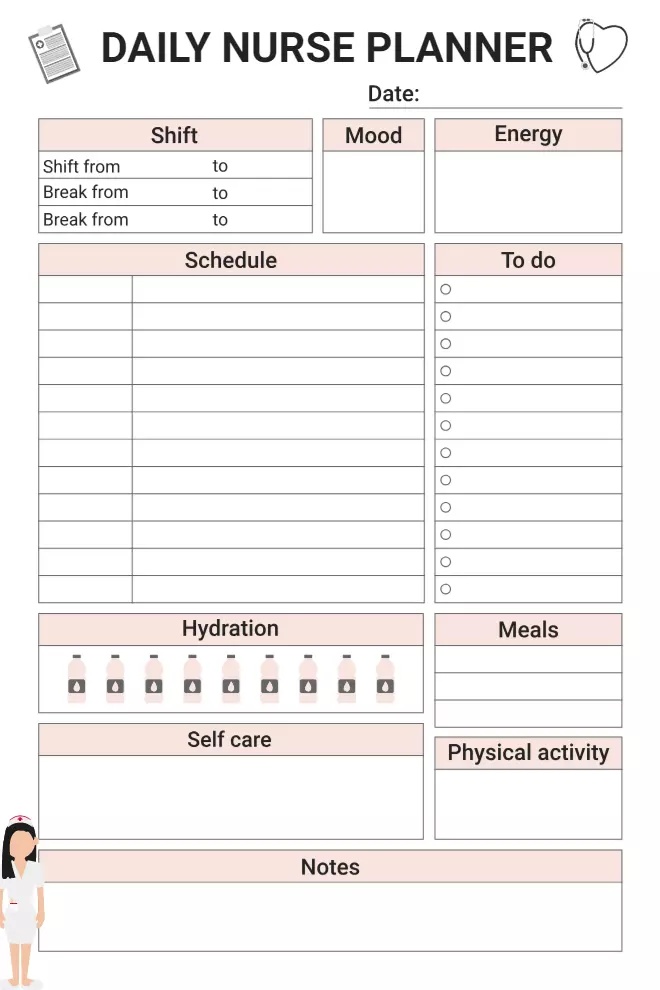The daily nurse planner template helps nurses stay organized by managing their shift schedules, tasks, and well-being. With features to track hydration, mood, and self-care, it ensures nurses maintain balance during busy shifts. Using the PlanWiz nurse daily planner app allows easy access to everything in one place, improving productivity while supporting personal health on the job.
Aesthetic nurse planner templates exist to satisfy all requirements that nurses need to achieve. The system presents an interface that integrates practical organization with design elements that ensure intuitive usage. Nurses benefit from structured segments in the templates, which help them schedule shifts along with monitoring their health progress effortlessly.
Through the structured shift presentation and pleasing visual design, nurses can use this daily planner to control their daily work and health needs efficiently. The template features an organized format that contains areas to plan shifts as well as track meals and nutritional reminders. The workplace design helps nurses balance work and personal tasks, boosting job satisfaction and performance. Beyond nursing-specific layouts, healthcare professionals can also explore various aesthetic planner templates to find designs that resonate with their personal style while maintaining functionality.
How Does an Aesthetic Daily Nurse Planner Template Improve Shift Planning?
The nurse planner template is designed with structured sections for shifts, scheduling tasks, and self-care. Its focus on priorities, time management, and well-being helps nurses arrange their tasks effectively. By using smart ways to organize their daily nurse planner, nurses can maintain balance, reduce stress, and improve workflow while ensuring excellent patient care and personal health.
Clear Visualization
The segmented layout design establishes a clear visual presentation, which helps nurses organize their daily shift activities better. The document separates content into sections for scheduling, tasks, and well-being for easy use and organization. The organized structure reduces stress, allowing nurses to focus on patient care without feeling overwhelmed.
Dedicated Sections for Key Aspects
The planner contains scheduling and task-subsections as well as sections focusing on meal planning and hydration and self-care needs to maintain equilibrium. Through the use of trackers, nurses will be able to maintain professional commitments while they care for their health to establish a balanced work-life schedule. The complete planning framework leads to enhanced operational efficiency.
Prioritization and Time Management
The segmental planner enables nurses to allocate their time efficiently, giving priority to essential tasks. Each section of the planner helps organize responsibilities and eliminate last-minute stress. By following time management tips, nurses can improve focus, reduce burnout, and enhance productivity, ensuring smoother shift transitions and better patient care outcomes during demanding work shifts.
Adaptability to Different Shifts
The planner shows flexibility through its ability to accept different shift arrangements from daytime to nighttime and periodically changing schedules. Medical staff can modify the planner sections to fit their work responsibilities, thus achieving organized and structured shift operations. The flexible planning solution boosts efficiency, allowing healthcare staff to stay productive across various shifts.
Reduced Cognitive Load
When information about shifts becomes organized, it decreases mental effort, which enhances the speed of decisions. The planner helps nursing staff devote attention to patient care through reducing mental exhaustion, which arises from disordered work timetables. Professional healthcare delivery improves with reduced stress as planners create efficient workflows, enhancing focus and service quality.
How Do the Icons Enhance the Aesthetic of the Daily Nurse Planner Template?
The nurse daily planner template benefits both aesthetically and functionally from the use of icons. These small graphics enhance the planner’s look while improving navigation. Icons serve as visual markers for key sections like schedule, mood, and hydration, striking a balance between design appeal and usability. They also allow for customization, making task organization more efficient.
- Visual Appeal: The icons add visual interest and break up the text, making the planner more engaging and visually appealing. This can contribute to a more positive user experience and encourage consistent use.
- Symbolic Representation: Each icon represents a specific section or activity, such as a clipboard for the “Schedule” section, a heart for “Mood,” and water bottles for “Hydration.” These symbols provide visual cues that aid in quick recognition and navigation of the planner.
- Thematic Reinforcement: The icons reinforce the theme of holistic well-being, with symbols representing both professional duties (schedule, tasks) and personal wellness (mood, energy, meals, hydration, self-care).
- Personalization and Customization: The icons can be personalized or replaced with different symbols that resonate with individual nurses, allowing for a sense of ownership and customization.
- Accessibility and Inclusivity: The use of simple, universally recognizable icons makes the planner accessible to nurses from diverse backgrounds and language proficiency.
What is the Role of a to-do List in an Aesthetic Daily Nurse Planner Template?
The daily nurse planner template features a crucial “to-do” list that enables effective task organization. It helps nurses manage their duties efficiently while tracking progress and delegating tasks as needed. Additionally, you can enhance productivity with these to-do list apps to streamline task management and ensure a smooth workflow during shifts.
Task Management
The to-do list in daily nurse planner templates allows staff to handle their tasks effectively. The daily nurse planner features an allocated space for listing assignments to prevent any tasks from getting lost in chaos. The methodical approach decreases stress while improving workflow and reducing error, thus providing nurses with better organization during daily shift management.
Prioritization
Nurses should use the “To-Do” list to arrange duties by criticality and urgency. This systematic prioritization lets them address the most pressing responsibilities first, boosting both efficiency and patient care quality. By prioritizing tasks for a smooth nursing shift, proper task structuring enhances workflow, minimizes delays, and provides a strategic approach to nursing responsibilities.
Delegation and Collaboration
The “To-Do” list makes teamwork possible through its capabilities for task delegation between nurses. Managing responsibilities for tasks leads to working coordination that limits individual workload and decreases burnout risk. Better work efficiency results from collective nursing approaches alongside a supportive workplace culture that ensures the coverage of all responsibilities for patient care excellence.
Progress Tracking
Success comes through marking finished tasks on the “To-Do” listing. The visual task tracking system both inspires nurse engagement and helps them meet each deadline for their assigned responsibilities. The system enables nurses to track work progress, which supports their productivity levels and their ability to deliver superior patient care over the shift duration.
Reduced Mental Clutter
Writing tasks in the “To-Do” list serves to reduce mental overload, which helps nurses to concentrate more efficiently. The transfer of responsibilities into external spaces helps nurses free up their thinking capacity, which enhances their ability to focus and make decisions. This technique reduces forgetfulness, enhances efficiency, and provides clarity, minimizing stress and fatigue for nurses.
Does an Aesthetic Daily Nurse Planner Template Help Track Hydration?
Hydration stands as a crucial section within the daily nurse planner template that facilitates hydration promotion. The template draws attention as a visible prompt to act as a reminder. The planner prompts nurses to maintain regular water intake throughout their working hours. Thus keeping hydration at the forefront of their attention. This basic prompt decreases the risk of work-related dehydration.
The planning document with hydration goals helps nurses better understand their fluid consumption. Each interval of water intake gets documented by nurses within specific measurement types. Through this planning technique, staff nurses maintain sufficient water consumption throughout their work hours.
The template offers a tracking mechanism to protect employees from dehydration risks. Real-time tracking helps nurses adjust their water intake if needed. The system sends personalized alerts, ensuring hydration remains a priority throughout each shift. The hydration section of the planner promotes healthy habits, helping nurses sustain energy and focus during shifts.
Conclusion
The daily nurse planner template plays a crucial role in streamlining shift management. With its organized structure, task prioritization, and hydration tracking, it supports nurses in staying efficient and healthy. A notes planner for nurses further aids in documenting key observations, enhancing communication, and ensuring important details are captured, improving overall shift management and patient care.








